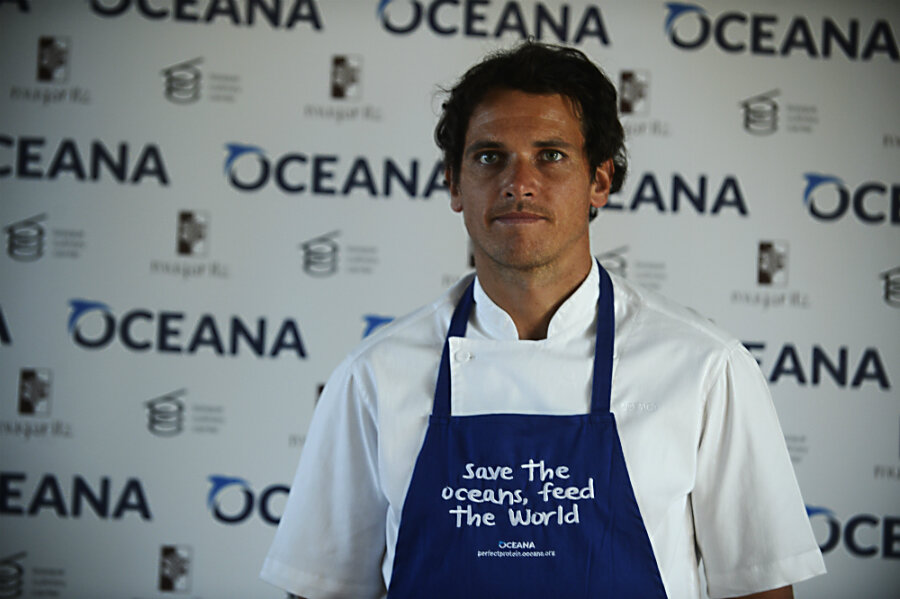Seaweed helps bring food security to Latin America
Loading...
Zulema Muñoz collects seaweed in a small coastal town 100 miles south of Santiago, Chile. A photo published by Inter Press Service shows her emerging from the water with a green bag tied at her waist, two large seaweed plants trailing behind her like Medusa’s mane. A good week may see her cut 1,100 pounds of seaweed from the rocks where it grows, IPS reported.
Muñoz is one of the 30,000 people for whom Chile’s seaweed industry provides a livelihood. Throughout Latin America, the cultivation and collection of seaweed are gaining a foothold both as a source of food and as a means of bolstering food security in a region where 34 million people are food insecure and poverty affects 47 percent of the rural population, according to the Food and Agriculture Organization. Countries such as Argentina, Brazil, Colombia, Cuba, Ecuador, Mexico, Peru, and Venezuela have all explored seaweed production for food. Yet as demand outpaces production and wild stocks have become depleted, more attention is being paid to sustainable cultivation and harvesting methods that can keep the industry afloat.
Seaweed has a long history in South American cuisine, one that predates colonization. The indigenous cooking of Chile made frequent use of protein-rich cochayuyo, the most abundant of the country’s 750 species of seaweed. Today, cochayuyo is commonly found in place of meat in charquicán, a traditional stew, as well as salads, empanadas, and ceviches.
Today, what’s old is new again. Call it a “re-enchantment with algae,” as Axel Manríquez, head chef at the Plaza San Francisco Hotel in Santiago, told IPS – and South America’s best chefs are also some of kelp’s best boosters.
Like Muñoz, chef Rodolfo Guzman hunts Chile’s shoreline for seaweed – in addition to sea figs, beach chard, sea parsley, rock clovers, and sea asparagus – for his award-winning Santiago restaurant, Borago. Working closely with biologists, anthropologists, and mushroom specialists, he developed a menu of haute Chilean cuisine based on these indigenous marine plants. Sound like a famous restaurant in Copenhagen? In neighboring Bolivia, Claus Meyer, the other half of the team behind Noma, opened the restaurant Gustu with a similar goal. Showcasing the region’s native produce, Gustu serves alpaca, llama, and river trout with cochayuyo.
Kelp as the new kale is a global trend too, and for good reason. Nutritionally, seaweed is packed with iodine and other nutrients, and its umami-heavy flavor appears on trend-making menus in Google’s New York cafeteria and the East Village’s punk rock vegetarian heaven Superiority Burger.
“It’s a kelp tsunami,” Bren Smith, kelp crusader, said in a recent interview with TakePart. “I was expecting 10 years to get people to eat this weird, disgusting stuff.”
While 83 percent of cultivated sea vegetables are produced for human consumption, we aren’t just eating it. Seaweed is used in fertilizers and animal feed, and seaweed-based food additives are likely in many products in your kitchen and bathroom right now. Carrageenan, made from red seaweed, is in everything from shampoo and toothpaste to ice cream and vegan hot dogs. For years, scientists have been talking about its potential as a biofuel.
While seaweed grows readily, there isn’t an infinite supply – and there are concerns that humans are taking too much of the wild stuff. “It is possible that overexploitation of natural seaweed resources could lead to significant ecological, economic, and social consequences at local, regional, and even global scales,” a global team of scientists wrote in the Journal of Applied Phycology. In Latin American countries like Brazil and Peru, where the seaweed industry is based on harvesting wild seaweed rather than cultivated, the authors called the need for environmentally friendly models “urgent.”
On this front, Chile has been a leader in sustainability in South America not only for the seaweed stock, but also for the food security of its residents. The Chilean government passed a law to promote repopulation of natural seaweed beds. By offering compensation to small seaweed collectors, the government promotes seaweed cultivation and provides livelihoods.
Continuing to develop sustainable seaweed models like Chile’s throughout Latin America could increase food security and the quality of life for women like Muñoz. Take Tanzania: There, 90 percent of seaweed farmers are women, and the industry has “liberated them from poverty.” There’s a domino effect: Across the globe, when women gain economic independence, childhood malnutrition goes down, and education goes up.
It’s like Chilean President Michelle Bachelet said at last summer’s FAO conference: “Women hold the keys to food security.” For some, that key is kelp.
• Sarah McColl has written for Yahoo Food, Bon Appétit, and other publications. She's based in Brooklyn, New York.
• This article originally appeared at TakePart, a leading source of socially relevant news, features, opinion, entertainment, and information – all focused on the issues that shape our lives.







